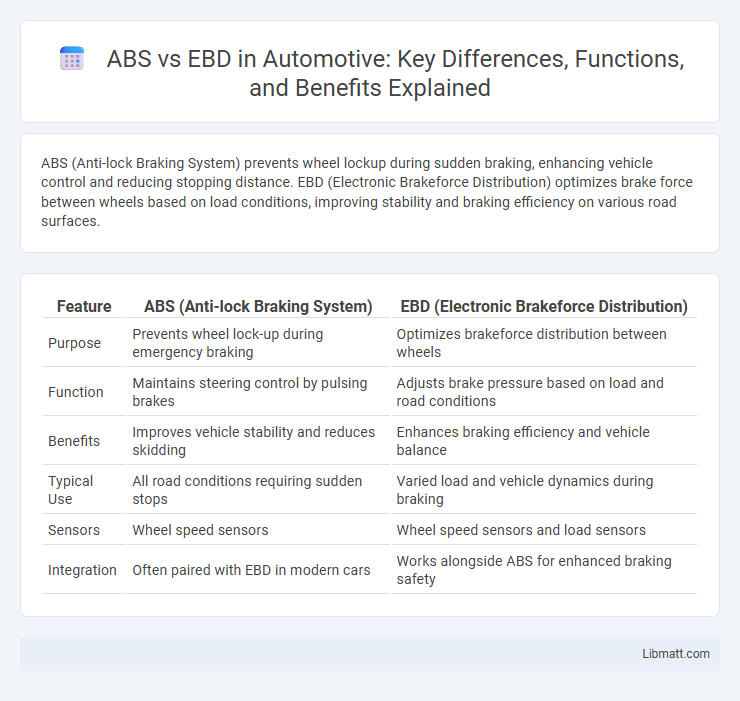ABS (Anti-lock Braking System) prevents wheel lockup during sudden braking, enhancing vehicle control and reducing stopping distance. EBD (Electronic Brakeforce Distribution) optimizes brake force between wheels based on load conditions, improving stability and braking efficiency on various road surfaces.
Table of Comparison
| Feature | ABS (Anti-lock Braking System) | EBD (Electronic Brakeforce Distribution) |
|---|---|---|
| Purpose | Prevents wheel lock-up during emergency braking | Optimizes brakeforce distribution between wheels |
| Function | Maintains steering control by pulsing brakes | Adjusts brake pressure based on load and road conditions |
| Benefits | Improves vehicle stability and reduces skidding | Enhances braking efficiency and vehicle balance |
| Typical Use | All road conditions requiring sudden stops | Varied load and vehicle dynamics during braking |
| Sensors | Wheel speed sensors | Wheel speed sensors and load sensors |
| Integration | Often paired with EBD in modern cars | Works alongside ABS for enhanced braking safety |
Introduction to ABS and EBD
Anti-lock Braking System (ABS) prevents wheel lock-up during sudden braking, maintaining steering control and improving vehicle stability on slippery surfaces. Electronic Brakeforce Distribution (EBD) optimizes the distribution of braking force between front and rear wheels based on load conditions, enhancing overall brake efficiency and reducing stopping distances. Together, ABS and EBD enhance safety by preventing skidding and ensuring balanced braking performance under varying driving conditions.
How ABS Works
ABS (Anti-lock Braking System) prevents wheel lock-up during sudden braking by rapidly modulating brake pressure through electronic sensors and hydraulic valves. This system maintains tire traction with the road surface, allowing you to steer while braking hard and reducing the risk of skidding. By continuously monitoring wheel speed, ABS ensures optimal braking performance and enhanced vehicle control in emergency situations.
How EBD Functions
Electronic Brakeforce Distribution (EBD) enhances vehicle safety by automatically adjusting brake pressure to each wheel based on load and road conditions, preventing wheel lockup and ensuring optimal stopping power. Unlike ABS, which primarily prevents wheel skidding during hard braking, EBD dynamically balances brake force between the front and rear wheels to maintain stability and reduce stopping distances. Your braking system relies on EBD to improve control and effectiveness, especially during uneven loads or emergency maneuvers.
Key Differences Between ABS and EBD
ABS (Anti-lock Braking System) prevents wheel lock-up during hard braking, ensuring vehicle stability and steering control, while EBD (Electronic Brakeforce Distribution) optimizes brake force between front and rear wheels based on load and road conditions for balanced stopping power. ABS activates to maintain traction and avoid skidding, whereas EBD dynamically adjusts braking pressure to enhance overall braking efficiency and reduce stopping distance. Both systems work together to improve safety but focus on different aspects of brake performance and vehicle control.
Advantages of ABS
ABS (Anti-lock Braking System) prevents wheel lock-up during emergency braking, ensuring better steering control and shorter stopping distances on slippery surfaces. It enhances vehicle stability by maintaining traction, reducing the risk of skidding and accidents. Your driving safety improves significantly, especially in adverse weather conditions, thanks to the reliable performance of ABS.
Benefits of EBD
Electronic Brakeforce Distribution (EBD) enhances vehicle safety by automatically adjusting brake pressure to each wheel based on load conditions, improving stability and reducing stopping distance. Unlike traditional Anti-lock Braking Systems (ABS) that prevent wheel lockup, EBD optimizes braking efficiency by balancing force distribution, particularly during cornering or uneven road surfaces. This targeted brakeforce control minimizes tire wear and ensures better control, especially in emergency braking scenarios.
Safety Impact: ABS vs EBD
ABS (Anti-lock Braking System) prevents wheel lockup during hard braking, maintaining steering control and reducing the risk of skidding on slippery surfaces. EBD (Electronic Brakeforce Distribution) optimizes brake pressure between front and rear wheels, enhancing vehicle stability and minimizing stopping distances during uneven load conditions. Understanding the differences in safety impact between ABS and EBD helps you make informed decisions for improved braking performance and overall road safety.
Common Myths About ABS and EBD
Common myths about ABS (Anti-lock Braking System) and EBD (Electronic Brakeforce Distribution) include the belief that ABS always reduces stopping distance, whereas it primarily prevents wheel lockup and maintains steering control during emergency braking. Another misconception is that EBD functions independently of ABS, while EBD actually works in conjunction with ABS to adjust brake force distribution for enhanced vehicle stability. It is also wrongly assumed that these systems eliminate all risk of skidding, despite their role in improving control rather than guaranteeing skid prevention on slippery surfaces.
Integration of ABS and EBD in Modern Vehicles
Modern vehicles integrate ABS (Anti-lock Braking System) and EBD (Electronic Brakeforce Distribution) to optimize braking efficiency and safety. ABS prevents wheel lock-up during sudden stops, while EBD automatically adjusts brakeforce between front and rear wheels based on load and road conditions. Your vehicle benefits from this seamless integration by maintaining better control and stability during emergency braking situations.
Choosing the Right Braking System for Your Car
When choosing the right braking system for your car, understanding the differences between ABS (Anti-lock Braking System) and EBD (Electronic Brakeforce Distribution) is crucial. ABS prevents wheel lock-up during sudden braking to maintain steering control, while EBD optimizes brakeforce distribution between wheels for balanced stopping power under varying loads. Prioritizing a system that combines both ABS and EBD enhances your vehicle's safety by improving stability and braking efficiency in diverse driving conditions.
ABS vs EBD Infographic

 libmatt.com
libmatt.com